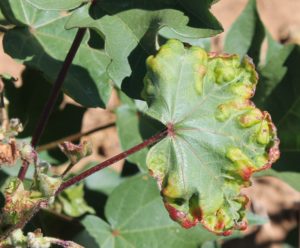New cotton technologies add to grower responsibilities
Writer: Steve Byrns, 325-653-4576, [email protected]
Contacts: Dr. Seth Byrd, 806-746-6101, [email protected]
Dr. Peter Dotray, 806-746-6101, [email protected]
LUBBOCK – From a cotton farming standpoint, it may be more important now than ever to know your surroundings, said a pair of Texas A&M AgriLife Extension Service specialists at Lubbock.
In the past, farmers used to plant brown bag seed and had few postemergence herbicide options, said Dr. Seth Byrd, AgriLife Extension agronomist. But with today’s genetic weed-fighting seed technologies and new formulations of old active ingredients, there’s an almost bewildering array of parameters growers must follow to abide by label requirements and minimize risk of damaging their crops or those of others.
Byrd and Dr. Peter Dotray, AgriLife Extension weed specialist, said problems could occur if growers do not carefully apply these new auxin herbicide formulations in the new cotton varieties. Growers must be aware of susceptible crops and sensitive habitats nearby.
“Many cotton producers will be planting different types of the new herbicide-resistant cotton varieties this spring that carry auxin or other broadleaf weed herbicide-resistant traits,” Dotray said. “But they and/or their neighbors may well be planting or have other crops that are highly sensitive to auxin herbicides including grapes.

“Application stewardship…think ‘responsibility,’ has become a constant mantra at all our single and multi-county AgriLife Extension meetings this winter. But it’s an extremely important message, so it’s our hope everyone by now is well-aware of the need to properly utilize these new technologies to avoid any unpleasant issues with off-target herbicide drift to protect their neighbors’ crops…as well as their own.
“This has been and will continue to be a unified message delivered by AgriLife Extension and Texas A&M AgriLife Research and allied industry statewide.”
From the cotton variety perspective, Byrd said it’s important to understand the differences between the new technologies.
The 2,4-D resistant cotton from Dow AgroSciences is called Enlist and includes the W3FE genetic trait package. It’s included in several varieties in the PhytoGen Cottonseed company brand.

Byrd said the dicamba herbicide-resistant cotton from Monsanto is called XtendFlex and includes the XF and B2XF genetic trait packages. These trait packages will be included in several varieties from Deltapine, Americot/NexGen, All-Tex/Dyna-Gro and CROPLAN Genetics brands.
Byrd and Dotray said farmers should take copious notes in order to keep everything straight as to who planted what, where. And that’s in addition to their constant admonishment to always read and follow any and all accompanying label directions when dealing with any type of pesticide.
“Both the Enlist cotton and XtendFlex cotton will be resistant to three different herbicides,” Dotray said. “They both will be resistant to glyphosate (Roundup) and glufosinate (Liberty); however, the third piece, which is either 2,4-D choline resistance or dicamba resistance, will be unique to one, but not both technologies. In other words, there are no 2,4-D choline and dicamba cross-resistant cotton varieties.
“Bottom line, and this is important, you can’t spray Enlist Duo, a new herbicide premix formulation containing 2,4-D choline plus glyphosate on XtendFlex cotton and you can’t spray any dicamba formulation, including the new dicamba-resistant formulations of XtendiMax with VaporGrip from Monsanto or Engenia from BASF, on Enlist cotton. If you do, you’ll kill your cotton and possibly your neighbors’ as well as other susceptible crops.”
Dotray said a “systems” approach will be critical for season-long control of troublesome weeds.
“Our research shows that XtendiMax or Engenia herbicides in XtendFlex cotton and Enlist Duo in Enlist cotton will help manage hard-to-control weeds including glyphosate-resistant Palmer amaranth.”
Dotray said the first principle for effective weed management is to start with a clean field. He said tillage, preplant burndown herbicides and preplant incorporated dinitroaniline herbicides such as Treflan and Prowl will play a critical role in starting clean.
“Preemergence and early postemergence herbicides will also play an important role in a dicamba-based or 2,4-D-based cotton weed control systems,” Dotray said. “Mid- and late-postemergence applications may be needed to effectively manage weeds until the end of the season.
“Any missed weeds should be removed, even if you have to pull them individually, because as an example, just one resistant Palmer amaranth plant can yield 600,000 seeds or more, greatly adding to your future weed infestation frustrations.”
When applying these new XtendiMax, Engenia and Enlist Duo herbicide formulations, Dotray said growers must be aware of not only the chemicals’ properties, but also the application requirements.
These include preplant and in-season herbicide-use rates per application per season, targeted weed size, nozzle selection, ground speed, boom height, wind speed and direction, the buffer requirements needed around the field to protect sensitive areas and susceptible crops and approved tank mix additives such as other herbicides and adjuvants, which are used to help stick the herbicide to the plant.
Websites Dotray recommends for help with application requirements are: XtendiMax, www.xtendimaxapplicationrequirements.com; Engenia, www.EngeniaTankMix.com; and Enlist Duo, www.EnlistTankMix.com.
“Of the new traits and technologies, we’re likely to see more West Texas acres planted to varieties with the XtendFlex trait than Enlist, mostly due to seed availability and because producers have more experience with the XtendFlex cotton varieties,” Byrd said.
“We had several of these in our on-farm variety RACE Trials last year that did well in irrigated and dryland tests. However, we also had varieties without the XtendFlex trait that did well. Cost is another consideration, because seed with the new traits is expensive, so unless it is really needed, I expect many of the dryland acres will continue to be planted using older RF or GT varieties or conventional varieties to keep costs down.”
Byrd and Dotray recommend that the total package, both of the variety and issues in the field that a variety or trait package can address, should be considered when making decisions on the value of the new technologies.
“If there is comfort with being able to stick to the label requirements then these technologies provide an excellent tool for weed management and cotton production,” Byrd said.


